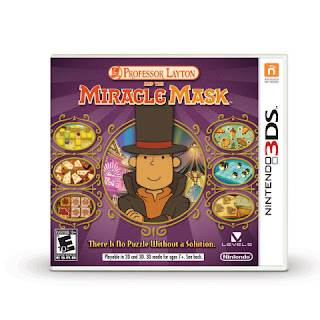While gamers in Japan are eagerly awaiting the final part of the Professor Layton prequel trilogy, those of us in the West are relieved to finally get our hands on what was a Japanese 3DS launch title, Professor Layton and the Miracle Mask — originally known as Professor Layton and the Mask of Miracle in Japan. After four critically acclaimed and immensely popular DS titles, this 3DS debut for the series carries on the over-arching story which first began in Professor Layton and the Last Specter, taking it to a new level of narrative while giving fans of the series everything they could possibly expect. It's a slight variation on a well-known formula but that ultimately matters little, as the challenge of solving the game's puzzles is rewarding enough.
If you're unfamiliar with Professor Layton — it's astonishing if you are — then you should know that at its core it's a collection of 150+ clever, challenging puzzles for you to figure out and solve. The fact that the majority are immaculately constructed helps, but what sets the series apart is its characterisation and story-telling. This time around Professor Hershel Layton, his assistant Emmy Altava and plucky young apprentice Luke Triton travel to Monte d’Or, an exceptionally wealthy and glamorous city in the middle of the desert, to help an old childhood friend. Throw in a mythological ancient civilisation and it may sound like a rather routine affair, but it's important not to think that this is an unimaginative re-tread of well-known tales.
The story that unfolds has its share of faintly ludicrous moments, though that's hardly a first for the series; we are playing as a Professor of Archaeology who solves life-threatening dangers with a tricky puzzle, after all. Like previous entries though, it's a storyline that accurately captures much of what makes the series so loved by its fans: it's full of humanity, charm and occasionally tragedy, giving genuine insight into Layton's beginnings as a lover of puzzles and mysteries. It's an immensely personal story this time around that shows us more of the Professor's late teens, during which we see his home town, parents and some of his dearest old friends. The beautifully animated cut-scenes are a highlight as always — despite the occasionally noticeable artefacts from the video compression process — that do much of the major storytelling, but modest enhancements courtesy of the capabilities of the 3DS system add a little more verve to the visuals and, by extension, the tale they tell.
We say modest, as the lasting impression won't prompt awow factor, but what Level-5 has actually done is completely overhaul the game's engine, from almost-static 2D screens to fully-realised 3D models. In dialogue sections — of which there are plenty — as well as the occasional engine-based cut-scene, the new visuals and animations are extremely effective at bringing the characters to life in a way that's likely to charm all but the coldest cynics. You'll be looking at character models with exceptionally chunky polygons and almost devoid of any texture, but it fits the fantasy of Layton's world rather well. You'll even see the new art style influence the occasional puzzle, though most could easily be replicated on a DS predecessor. The stereoscopic 3D plays its part in adding to the visual style, though it's disposable and shows the odd-sign of being one of the system's first titles — Layton's pointing finger does come out of the screen nicely, for example, but with a bit of ghosting on the highest setting.
Subscribe to:
Post Comments (Atom)











0 comments:
Post a Comment
Note: Only a member of this blog may post a comment.